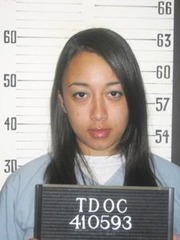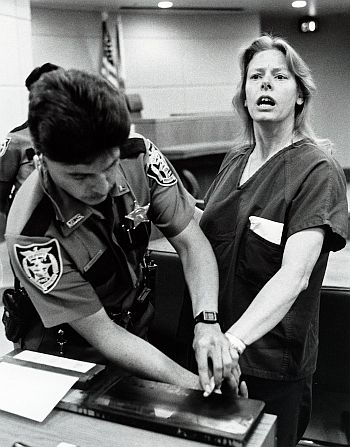

 By VennerRoad, 26th Nov 2017
By VennerRoad, 26th Nov 2017
Traditionally, the prostitute is looked on as a fallen woman. There are other views though.

Teen killer Cyntoia Brown
We are all familiar with the Biblical harlot, and that famous passage in which the Great JC prevents a crowd from stoning such a woman to death. Not all ancient societies condemned prostitution and prostitutes; in Rome, prostitution was legal and did not carry the same stigma it does even to this day.
Whatever one’s moral view of prostitution, it was a realistic or at least a pragmatic way for a woman who had no
family and no marketable talents to keep herself alive or even to earn a
living. It is far too easy for us sitting in the warmth of our
centrally heated living rooms or air-conditioned parlours to condemn our
distant ancestors. The ancient world was a hard place in which to live
for even comparatively wealthy people. This was so up until fairly
recently. Before the welfare state, indigents were liable to end up in
the workhouse. If she had no family of her own, a young woman who was
exceptionally beautiful and ticked all the right boxes would find a
husband without too much trouble. But for those who were not...The word
“unfortunate” was once a euphemism for prostitute.
While historically, prostitution was viewed through the lens of religion, specifically Judeo-Christian morality, the misnamed women’s liberation movement of the 1960s and 70s, and now third wave feminism have given us two more narratives: prostitution as rape, and latterly, that of trafficking. Sandwiched between these is a third narrative, that of “sex work is real work”. How did this come about?
The idea of prostitution as rape is bizarre, but nowhere near as bizarre as pornography as rape, a narrative that was peddled if not created by two influential and toxic feminists, specifically Catharine MacKinnnon and Andrea Dworkin. MacKinnon is arguably the most influential feminist who has ever lived, as well as the most damaging to society. Her take on
pornography is beyond the scope of the current dissertation, but her claim that prostitution equals rape is derived from her tortuous
semantics and twisted logic. For MacKinnon as for most other feminist
airheads, women have been not only subservient to men but subjugated by
them since time immemorial. Ignoring or being unaware of history, and
totally ignoring the realities of biology, the argument goes something
like this. There is a power imbalance between men and women because of
this historical inequality. Any sexual relationship in which there is a
power imbalance is not and cannot be consensual. Prostitution is based
on such a power imbalance. Therefore prostitution equals rape. And that
is without the usual rhetoric of men exploiting women’s bodies for their own gratification.
MacKinnon’s hatred not simply of prostitution but of men is highlighted by this insane quote from her 1991 book Toward A Feminist Theory Of The State, page 146 (notes redacted):
“Compare victims’ reports of rape with women’s reports of sex. They look a lot alike. Compare victims’ reports of rape with what pornography says is sex. They look a lot alike. In this light, the major distinction between intercourse (normal) and rape (abnormal) is that the normal happens so often that one cannot get anyone to see anything wrong with it.”
One might just as well argue that a charitable donation looks like blackmail, that a gift looks like theft, or that a dentist extracting a tooth looks like the torture scene from Marathon Man.
The reality is that like regular sex, prostitution is a voluntary transaction. The arguments used to dress it up as rape do not wash. Yes, it is true that women can become “trapped” in prostitution, but this
can and does happen to many other people, men as well as women. It is
true that most prostitutes would rather be doing something other than
selling or more accurately hiring out their bodies, but the same can be
said of all professions. The guy who empties your trash would probably
rather be sunning himself on a Caribbean beach or playing a round of
golf, but he too has a hard life.
Here is something to ponder, a cameo from a UK soap opera a few years ago. The stunningly attractive
daughter of a wealthy man went off the rails, drinking too much. One
night she picked up a man twice her age and took him home. The next
morning she woke up alone, but there was a £20 note on her bedside
table. He thought I was a prostitute, she sobbed. Now, imagine this in
real life. If she takes the money, has she been raped? If she thinks it
is hers, has she been raped or not? If she doesn’t notice it and someone
else takes it, the cleaner perhaps, what is the situation now? If she
takes the money then a week later meets the man and returns it, has this
rape been converted into consensual sex?
If a woman has sex with
a man she meets at a bar, misses her last bus, and he offers to pay for
her taxi, has she been raped? What if a woman has sex with a man, she
tells him it is her birthday, and he buys her an expensive present on
the spur of the moment, or simply gives her a cash present? There are
all manner of scenarios here, and some are borderline. A situation in
which one person gives money to another may have nothing to do with sex.
The woman concerned may simply be a freeloader, and her male friend a soft touch.

Aileen Wuornos
MacKinnon’s insane view of prostitution and more broadly of sexual relations as rape led to the development of the so-called Nordic model which criminalises the buyers of sexual services. As usual, attempts to regulate or in this case to destroy a market lead to Sevareid’s law kicking in; the proclaimed success of the Nordic model is a myth.
With especially the rise of the Internet, the sex industry is bigger than ever. Where once it was owned lock, stock and barrel by a small number
of (male dominated) companies, especially publishers, the cyber-world has enabled small operators to work in comfort from their own homes. The
selling of sexual services has now expanded far beyond regular prostitution, and indeed some of what is classed as sex work has little
in common with pornography, much less prostitution. To take just one example, some Amazons (female bodybuilders) make a comfortable living
out of hiring themselves out for one-on-one sessions with men. This can include mixed wrestling and female domination with no sexual contact.
When one of these women is “touched” by a client he is more likely to be feeling her bicep than a more intimate part of her anatomy. Indeed,
women who sell fantasy or simply their company might take umbrage at
being mentioned in the same breath as cheap tarts and whores.
Nevertheless, combined with regular prostitution, from call girls to streetwalkers,
these women, and at times men, make up the new, expanded sex industry,
and some have formed unions to protect their livelihoods. The English Collective of Prostitutes was founded over forty years ago; the International Union of Sex Workers
was founded at the turn of the Millennium; it is based in London, but
the concept behind it can be found the world over. Mostly such
organisations are concerned with the seedier side of the sex industry,
ie real prostitution, be it streetwalking or call girl, so-called escort
services, including male prostitutes, who are almost exclusively
providers of homosexual services.
Some of these activists also argue they perform a value public service, and to a degree it is
difficult not to agree with them. There are some people, including younger men, who are so physically repulsive that their chances of
finding a sexual partner much less a life partner are close to zero.
These include people with varying disabilities. In 1978, Tuppy Owens
founded the Outsiders Club which caters for such social inadequates and unfortunate people, women
as well as men. Academics who work in the same field now realise that
the question of selling and buying sexual services is a lot more nuanced
than bigoted dogmatists like Catharine MacKinnon would have us believe.
In recent years, the fourth narrative of prostitution as sex trafficking
has been popularised. MacKinnon has also used this narrative.
Prostitutes are said to be prostituted women or prostituted people; the
terms trafficked women and trafficked girls/children are also used.
So
what is trafficking? The image is of vulnerable women and girls being
coerced, bullied, blackmailed and at times kidnapped, forced to have sex
with men by their wicked (male) controllers. Recently, murderess
Cyntoia Brown has been back in the news.
When she appeared in court back in 2004, she was wearing pigtails and
looked more like a 12 year old than a 16 year old. Now she is being
portrayed as a child victim of trafficking with the suggestion not only
that she should be released forthwith but that she should never have
been in prison at all. However, while her story is tragic, as was that
of another teen killer, Emma Humphreys, Brown did not kill her pimp in any pretence of self-defence, rather she
murdered a client in cold blood. Johnny Allen was shot in the back of
the head for no apparent reason; then she burgled his home.
The term trafficked is used in a much broader sense than the implication of modern slavery. A man stops his car, has a short conversation with a
prostitute through the window, she climbs in the car, he drives round the corner and she gives him a “hand job”. She has been “trafficked”. How absurd is this?
Part of the inherent dishonesty of this narrative is to conflate child prostitution – ie child sexual abuse with
sex trafficking, and in the case of adult women, rape, so called forced
prostitution, with regular prostitution. We also see the usual
dishonest factoids and ludicrous statistics thrown around. According to
the misnamed SharedHope International website, “The common age a child enters sex trafficking is 14-16”.
This is complete rubbish. The late Chris Tame
used to say when they talk about protecting your children, what they
really mean is destroying your rights. The sexual exploitation of the
young is a matter for the police; adult prostitution should be a matter
for consenting adults.
Apart from the “sex work is real work” narrative, all the others promote the idea of prostitutes as victims,
and only as victims. It is true that prostitution can be a high risk
profession; streetwalkers are a natural target for serial killers. For
example, in a six week period in 2006, five young prostitutes were
murdered by Suffolk Strangler Steve Wright. Legalising prostitution
would make it safer. In the UK, the legal position is complex; selling
sex is not illegal, but if two women work from the same premises, for
safety, they are deemed to be running a brothel, which is not legal. But
the violence is far from one way.
On May 16, 1986, the Hackney Gazette reported on the trial of prostitute Doreen Farquason. In May 1985, she
and another prostitute agreed to have sex with Donald Olongo, but he
went off the idea of having sex with her when she started to undress and
he realised she had only one arm. An argument ensued, and she ended up
stabbing him in the eye with her high-heeled shoe. Surgeons were unable
to save it. For this outrage, Farquason received a mere two year sentence. A far more extreme case was that of serial murderess Aileen Wuornos
who was executed in 2002. More recently, a prostitute named Aurora
Gronan was given a ten month sentence for assaulting a Coventry police
officer. Fallen women indeed.
Last year, the BBC screened a TV series Welcome To Holbeck which followed a number of prostitutes in what is said to be Britain’s
only legal red light district. These women were foul-mouthed, scorbutic,
and frankly it is difficult to imagine even the most sexually
frustrated and desperate of men would patronise them, but for the most
part they were doing a brisk trade. Some had sad tales to tell, but like
every prisoner, every prostitute has her own, pathetic victim
narrative. Many of them claim to have been forced into prostitution by
circumstances – as though they had no other choices, to have been
blackmailed or otherwise coerced into it. Many claim to have been
sexually abused or raped before becoming prostitutes, but the classic Al
Stewart song Old Compton Street Blues is probably a more accurate template for most contemporary harlots.
In
spite of the rubbish she spouts about prostitution being akin to rape,
Catharine MacKinnon does make one good point. There should be a pathway
out of prostitution for those women who have become trapped in it and
want to get out. These are the women in the bottom end, this is not to
say there is a top end – a whore is a whore – but it is certainly noble
to enable people at the bottom of society to improve themselves. A much
bigger problem is that of serial offenders and people who have no marketable skills. The British Government Minister Chris Grayling tried this for minor offenders.
As with criminals, MacKinnon and others advocate job training. Younger prostitutes are unlikely to take this route because many regard it as easy money, and often it is good money. One reason it is so good is because like professional sportspeople, most prostitutes have a limited shelf life. A fifty year old prostitute is not going to turn as many ‘tricks’ or earn as much from each as one half her age. The economic realities of the disadvantaged can be ameliorated by universal basic income, but a discussion of that would take us too far afield.
For the moment, the total legalisation of prostitution would appear to be the most pragmatic approach. That doesn’t mean it should be encouraged, but removing it totally from the twilight world would free up resources to spend on more pressing social problems, especially in the United States where prostitution is currently illegal in every state except Nevada. The Holtzclaw case is a salutary reminder of what criminalising this victimless if sordid behaviour can lead to.
To Wikinut Articles Page